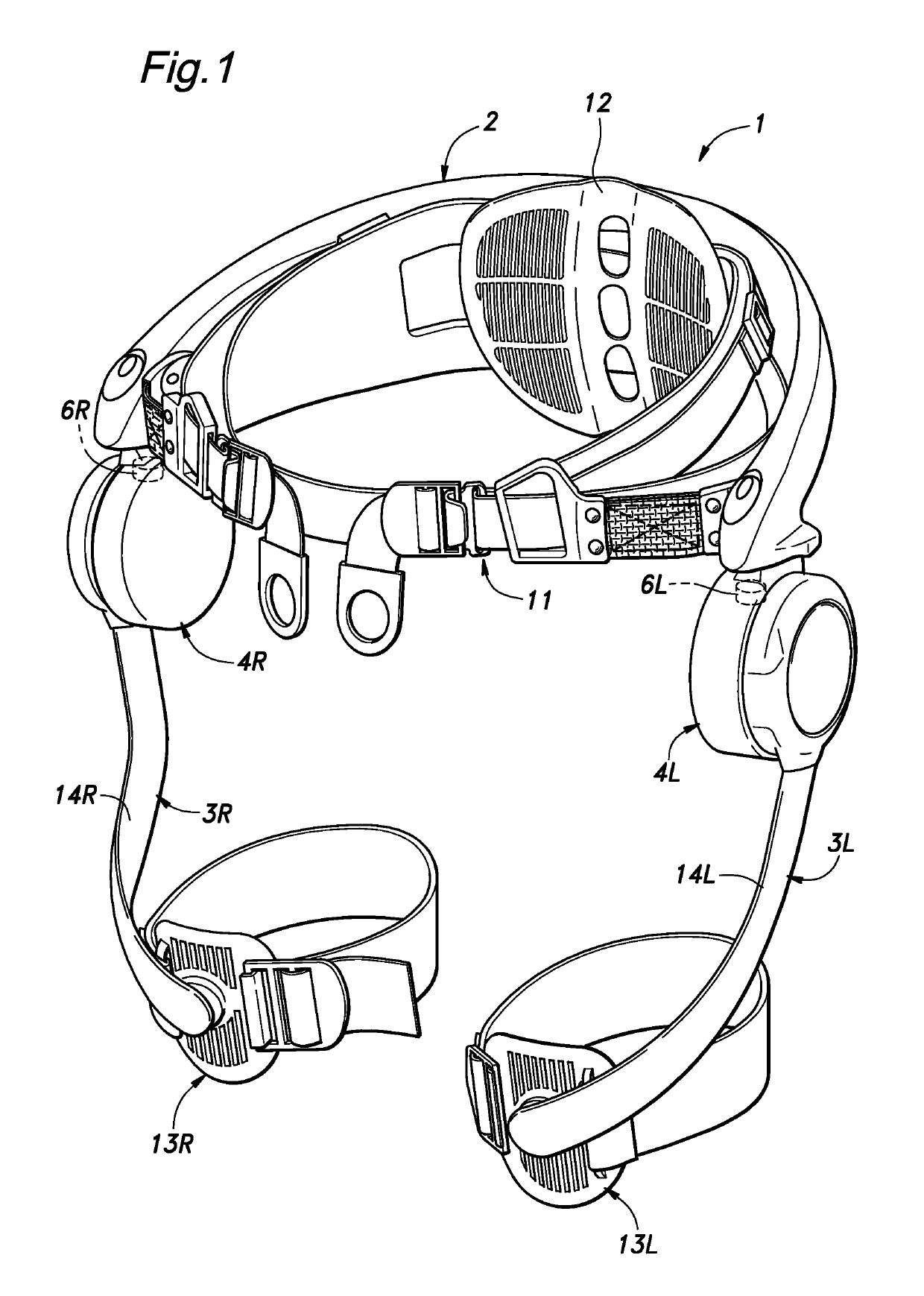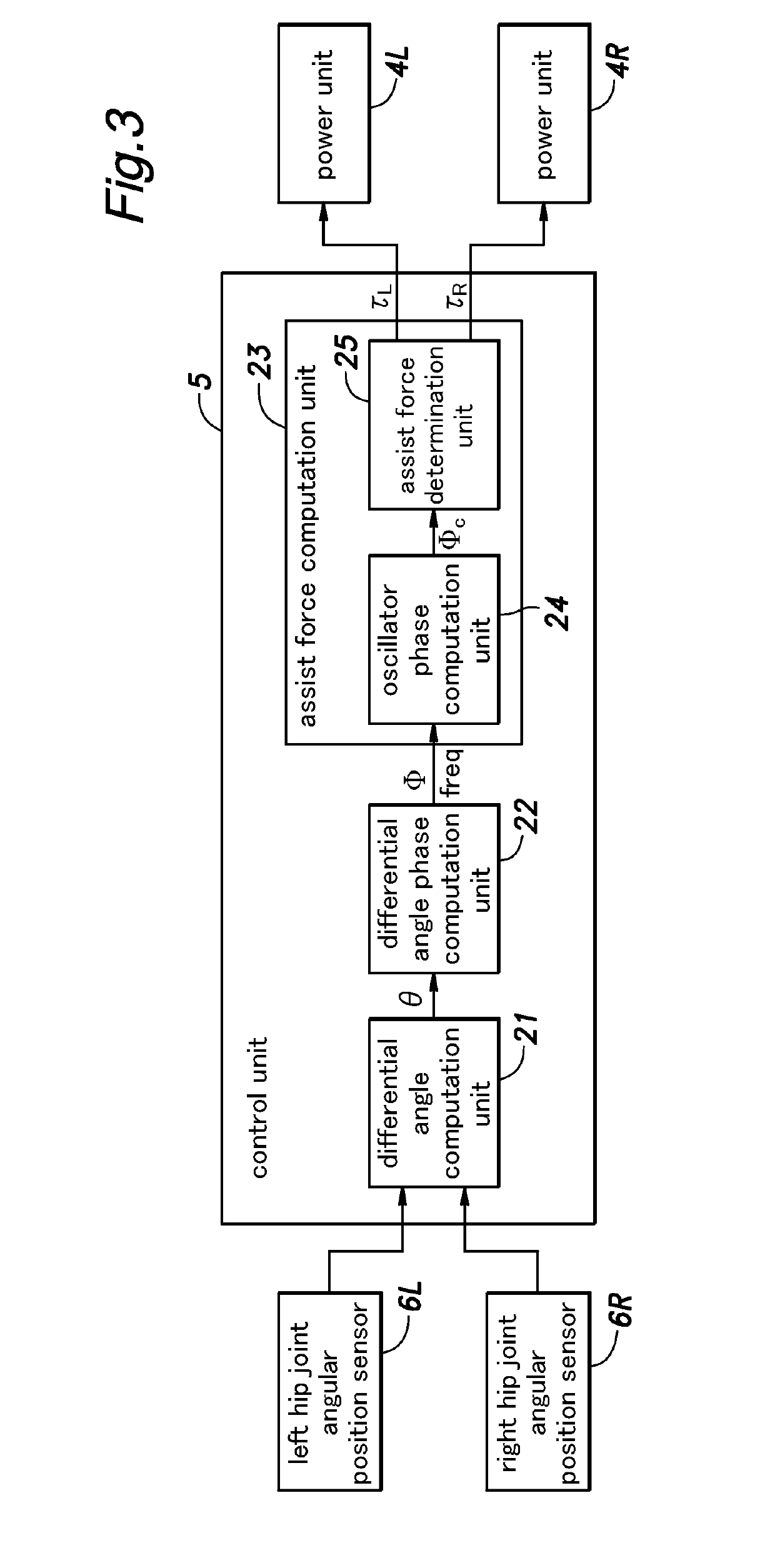Walking assist device
a technology of assist device and walking aid, which is applied in the field of walking assist device, can solve the problems of inability to produce the optimal assist force, difficulty in estimating the phase of motion of the lower limb, and inability to accurately estimate the phase of motion of the user's lower limbs
- Summary
- Abstract
- Description
- Claims
- Application Information
AI Technical Summary
Benefits of technology
Problems solved by technology
Method used
Image
Examples
first embodiment
[0044]As shown in FIG. 1, the walking assist device 1 of the first embodiment includes a main frame 2 configured to be worn on a pelvic part of the user P, a pair of femoral support units 3 (3L and 3R) pivotally attached to either side part of the main frame 2 at the positions corresponding to the hip joints of the user P at the base ends thereof via respective power units 4, a control unit 5 (See FIG. 3) for controlling the operation of the power units 4, a pair of angular position sensors 6 for detecting the angles of the femoral support units 3 provided at the respective pivoted base ends of the femoral support units 3 with respect to the main frame 2 and a battery (not shown in the drawings) for supplying electric power to the power units 4 and the control unit 5.
[0045]The main frame 2 is made of a combination of stiff material such as hard plastics and metals and flexible material such as fabrics and foamed plastics, and is secured to the pelvic part of the user P by a belt 11 ...
second embodiment
[0101]A second embodiment of the present invention is described in the following with reference to FIG. 10.
[0102]FIG. 10 shows a modification of the differential angle computation unit 21 of the walking assist device 1 of the first embodiment shown in FIG. 3. The structure and the functions of the second embodiment are otherwise similar to those of the first embodiment. Therefore, the parts corresponding to those of the first embodiment are omitted, and only those parts that are different from the counterparts in the first embodiment are described in the following. The same is true with other embodiments that are described later.
[0103]In this embodiment, instead of using absolute type angular sensors for the hip joint angular position sensors 6L and 6R of the first embodiment, incremental type angular sensors 61L and 61R for detecting the angles of the femoral parts relative to the main frame 2 are used as shown in FIG. 10. The differential angle computation unit 21 computes the dif...
third embodiment
[0106]FIG. 11 shows the structure of the differential angle computation unit 21 in a third embodiment of the present invention.
[0107]In this embodiment, the walking assist device 1 is provided with a left femoral G sensor 71L and a right femoral G sensor 71R for detecting the fore and aft accelerations of the respective femoral support units 3L and 3R, and a left femoral gyro sensor 72L and a right femoral gyro sensor 72R for detecting the angular speeds ω3L and ω3R of the respective femoral support units 3L and 3R, instead of the hip joint angular position sensors 6L and 6R of the first embodiment. The differential angle computation unit 21 computes the differential angle θ from the output signals provided by these sensors 71L, 71R, 72L and 72R.
[0108]The differential angle computation unit 21 is provided with a left and right strap-down attitude estimation units 73L and 73R for estimating the respective attitude angle vectors BL and BR by executing a strap-down attitude estimation ...
PUM
 Login to View More
Login to View More Abstract
Description
Claims
Application Information
 Login to View More
Login to View More - R&D
- Intellectual Property
- Life Sciences
- Materials
- Tech Scout
- Unparalleled Data Quality
- Higher Quality Content
- 60% Fewer Hallucinations
Browse by: Latest US Patents, China's latest patents, Technical Efficacy Thesaurus, Application Domain, Technology Topic, Popular Technical Reports.
© 2025 PatSnap. All rights reserved.Legal|Privacy policy|Modern Slavery Act Transparency Statement|Sitemap|About US| Contact US: help@patsnap.com



